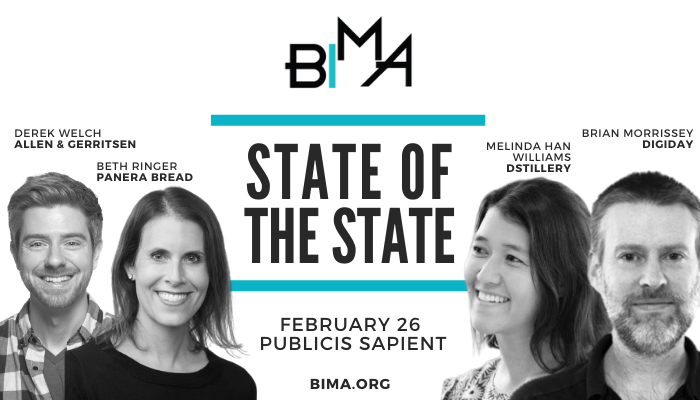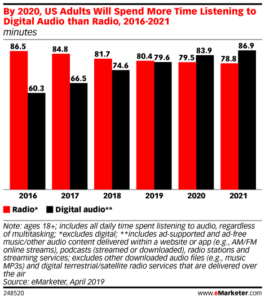
Three Big Takeaways for 2020 from BIMA’s State of the State
One of the things I love about being in the advertising industry is that you’re surrounded by people who are constantly thinking about how changes in the world will affect the way brands try to connect with people. This was the focus of the State of the State event last week in Boston, presented by the Boston Interactive Media Association (BIMA).
The event was kicked off by Brian Morrisey, President and Editor-in-Chief of Digiday, followed by a panel that I was lucky enough to be a part of. It was moderated by Brian, and included Beth Ringer, VP/Media Strategy at Panera Bread, Derek Welch, VP/Media at Allen & Gerritsen, and Melinda Han Williams, Chief Data Scientist at Dstillery.
Here were my top takeaways:
COOKIE-pocolypse
We of course had to address the announcement that Google would phase out support of third-party cookies for Google Chrome by 2022. I won’t share the image that Brian Morrisey used to kick off the event to show that cookies are being sacrificed like a martyr — let’s just say it was a bold move for Ash Wednesday. The overall feeling at the event was that while there is some tension among marketers and agency folks about the move, there wasn’t the level of panic expressed in some industry publications. First off, this move won’t have any real negative impact on YouTube advertising, which is where our focus is at Pixability. For other advertising channels that stand to see some impact, there’s a general feeling that there will be multiple solutions that will eventually serve a similar role of 3rd party cookies including Google’s Privacy Sandbox or various persistent ID solutions. Also, this move wasn’t a surprise to anyone, so while change is scary, this was a change we all knew was coming. All and all, the issue feels less like cookie-pocolypse, and more like a cookie-problem.
Big Winners in 2020: Digital Video and Digital Audio
There was a general sense, especially from folks to my left and right on the panel, that digital video and audio will play an outsized role in 2020 marketing plans. Many programmatic and/or display programs seem less effective and there are reasons (especially given the approaching cookie-problem) that open web ads are less attractive. As for video, we know that over 82% of internet consumption this year will be through that medium, with YouTube and Connected TV making up over half of the U.S. ad market. With audio, we know that 2020 is set to be the year where digital audio advertising surpasses radio (see the chart from eMarketer below). Beth Ringer from Panera, in particular, pointed to how interesting the opportunities are with podcasts as consumption grows. Overall, marketers have a better opportunity to tell stories on video and audio than with static ads, and 2020 will be a year when story-telling is particularly important.

Brand Safety, Brand Suitability, and Brand Reputation
Our panel talked about brand safety not as a new problem, but one that has new wrinkles. Every brand worries about an ad appearing against inappropriate content. But it’s important to go beyond that, and think about what’s suitable for their brand image. For example, a music video may be fine content to appear on for a video game advertiser, but not for a luxury watch advertiser. Our panel talked about how this kind of suitability consideration is something that not enough advertisers are thinking about — the strategy stops at brand safety. At Pixability, we don’t run video ads on news content on YouTube as a default, because we have advertisers that would see certain news content as “safe” but not “suitable.” A video about Donald Trump or Bernie Sanders may be totally safe, but may not be something certain brands want to associate themselves with. Similarly, we had a great question from the audience about how brands are using video advertising to tell the story of their brand and support their reputation. I pointed out examples like Panda Express. The company’s most watched video was one that talked about their commitment to Asian Pacific American Heritage month and saw exponentially more engagement than any other videos they made that were product-specific. Similarly, Frost Bank, a regional bank in Texas saw amazing success with an “Opt for Optimism” campaign, which had nothing to do with banking and everything to do with how they valued people. The takeaway from all of this is that it’s not enough to simply put product advertisements against brand-safe content. Brands need to “know who they are and what they stand for,” as one of the attendees of the event, Trupti Gupte Ram, Digital Marketing Manager at Keurig Dr. Pepper, so eloquently posted on LinkedIn following the event.
There are clearly many trends driving huge change in our industry in 2020, not the least of which will be the coronavirus (a story for another day). But the above trends felt like ones we could get our arms around at this event, and I was happy to be part of the conversation.